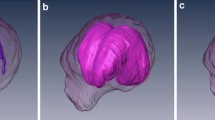Abstract
In patients with communicating or normal-pressure hydrocephalus, ventricular volume decreases following implantation of differential pressure valves. We implanted hydrostatic (Miethke dual-switch) valves in 60 patients with normal-pressure hydrocephalus (NPH) between September 1997 and December 2001. The patients underwent CT 1 year after operation, and we measured the Evans index. Although 83% of the patients showed no change in ventricular volume as assessed by this index, 72% nevertheless showed good to excellent and 16% satisfactory clinical improvement, while 12% showed no improvement. Moderate or marked reduction in ventricular size was observed in 17%, of whom 40% of these patients showed good to excellent and 20% satisfactory clinical improvement; 40% showed unsatisfactory improvement. The favourable outcome following implantation of a hydrostatic shunt thus did not correlate with decreased ventricular volume 1 year after operation, better outcomes being observed in patients with little or no alteration in ventricular size than in those with a marked decrease. Postoperative change in ventricular volume in NPH thus does not have the same significance as in patients with high-pressure hydrocephalus.



Similar content being viewed by others
References
Bergsneider M, Peacock WJ, Mazziotta JC, Becker DP (1999) Beneficial effect of siphoning in treatment of adult hydrocephalus. Arch Neurol 56: 1224–1229
Drake JM, Silva M, Rutka JR (1993) Functional obstruction of an anti-siphon device of raised tissue capsule pressure. Neurosurgery 32: 137–139
Meier U, Kiefer M, Bartels P (2002) The ICP-dependency of resistance to cerebrospinal fluid outflow: a new mathematical method for CSF-parameter calculation in a model with H-Tx rats. J Clin Neurosci 9: 58–63
Meier U, Zeilinger FS, Kintzel D (1999) Signs, symptoms and course of disease in normal-pressure hydrocephalus in relation to cerebral atrophy. Acta Neurochir (Wien) 141: 1039–1048
Meier U, Bartels P (2001) The importance of the intrathecal infusion test in the diagnostic of normal pressure hydrocephalus. Europ Neurol 46: 178–186
Meier U, Zeilinger FS, Kintzel D (1999) Diagnostic in normal pressure hydrocephalus: a mathematical model for determination of the ICP-dependent resistance and compliance. Acta Neurochir (Wien) 141: 941–948
Meier U, Kiefer M, Sprung C (2002) The Miethke Dual-Switch valve in patients with normal pressure hydrocephalus. Neurosurg Q 12: 114–121
Meier U, Kintzel D (2002) Clinical experiences with different valve systems in patients with normal-pressure hydrocephalus: evaluation of the Miethke dual-switch valve. Child's Nerv Syst 18: 288–294
Kiefer M, Eymann R, Meier U (2002) Five years experience with gravitational shunts in chronic hydrocephalus of adults. Acta Neurochir (Wien) 144: 755–767
Meier U (2002) The grading of normal pressure hydrocephalus. Biomed Engineering 47: 54–58
Pudenz RH, Foltz EL (1991) Hydrocephalus: overdrainage by ventricular shunts. A review and recommendations. Surg Neurol 35: 200–212
Sainte-Rose C, Hooven MD, Hirsch JF (1987) A new approach in the treatment of hydrocephalus. J Neurosurg 66: 213–226
Sainte-Rose C (1993) Shunt obstruction: a/// preventable complication? Ped Neurosurg 19: 156–164
Drake JM, Kestle JRW, Milner R, et al (1998) Randomized trial of cerebrospinal fluid valved shunt design in pediatric hydrocephalus. Neurosurgery 43: 294–303
Boon AJW, Tans JTJ (1998) Dutch normal pressure hydrocephalus (NPH) study. Randomised comparison of low and medium pressure shunts. Acta Neurochir [Suppl 71]: 401–404
Zemack G, Romner B (2000) Seven years of clinical experience with the programmable Codman Hakim valve: a retrospective study of 583 patients. J Neurosurg 92: 941–948
Richards HK, Seeley HM, Pickard JD (2000) Shunt revisions: data from the UK shunt registry. Eur J Pediatr Surg 10 [Suppl 1]: 59
Borgesen SE, Gjerris F(1987) Relationship between intracranial pressure, ventricular size, and resistance to CSF outflow. J Neurosurg 67: 535–539
Di Rocco C, Marchese E, Velardi F (1994) A survey of the first complication of newly implanted CSF shunt devices for the treatment of nontumoral hydrocephalus. Child's Nerv Syst 10: 321–327
Anderson RC, Grant JJ, de la Paz BA, Frucht S, Goodman RR (2002) Volumetric measurements in the detection of reduced ventricular volume in patients with normal-pressure hydrocephalus whose clinical condition improved after ventriculoperitoneal shunt placement. J Neurosurg 97: 73–79
Benzel EC, Pelletier AL, Levy PG (1990) Communicating hydrocephalus in adults: prediction of outcome after ventricular shunting procedures. Neurosurgery 26: 655–660
Pang D, Altschuler E (1994) Low-pressure hydrocephalic state and viscoelastic alterations in the brain. Neurosurgery 35: 643–656
Tans JT, Poortvliet DCJ (1989) Does compliance predict ventricular reduction after shunting for normal pressure hydrocephalus? Neurol Res 11: 833–837
Greenberg JO, Shenkin HA, Adam R (1977) Idiopathic normal pressure hydrocephalus-a report of 73 patients. J Neurol Neurosurg Psychiatry 40: 336–341
Yamashita N, Kamiya K, Yamada K (1999) Experience with a programmable valve shunt system. J Neurosurg 91: 26–31
Tsunoda A, Ebato M, Maruki C (2002) Clinical experience of a dual switch valve in the management of hydrocephalus: post-operative changes in ventricular size and intra-ventricular pressure. Jpn J Neurosurg 11: 592–597
Pollack IF, Albright AL, Adelson PD (1999) A randomized, controlled study of a programmable valved shunt versus a conventional valve for patients with hydrocephalus. Neurosurgery 45: 1399–1411
Author information
Authors and Affiliations
Corresponding author
Rights and permissions
About this article
Cite this article
Meier, U., Paris, S., Gräwe, A. et al. Is there a correlation between operative results and change in ventricular volume after shunt placement? A study of 60 cases of idiopathic normal-pressure hydrocephalus. Neuroradiology 45, 377–380 (2003). https://doi.org/10.1007/s00234-003-0989-x
Received:
Accepted:
Published:
Issue Date:
DOI: https://doi.org/10.1007/s00234-003-0989-x




